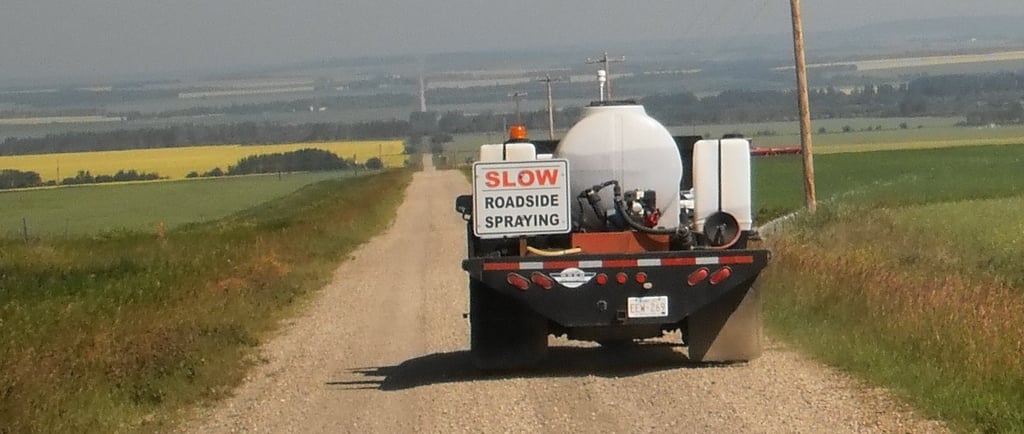Chemical Roadside Mowing – Is It Really The Most Cost Effective Solution?
For over 50 years, highways have been maintained using herbicides to control weeds, but this practice harms the environment by contaminating soil and water, threatening wildlife, and even posing health risks to humans.
9/24/20244 min read


The Harmful Effects of Herbicidal Spraying
Herbicidal spraying has a lengthy history, particularly along highways, with practices that date back several decades. Over the past 50 years, these methods, while aimed at controlling roadside vegetation, have led to severe environmental consequences. The continuous application of these chemicals has resulted in soil and water contamination, adversely impacting surrounding ecosystems. As herbicides are washed away during rain or irrigation, they infiltrate local waterways, leading to the degradation of aquatic habitats and the organisms that dwell within them. This contamination not only disrupts plant growth but also has far-reaching effects on wildlife populations that depend on healthy ecosystems for their survival.
The consequences extend beyond flora and fauna; human populations are also at significant risk. Those who live near sprayed roadways often face direct exposure to these toxic substances. Many herbicides contain carcinogenic components that can seep into drinking water supplies or be carried through the air, affecting individuals even at considerable distances from the treatment areas. Studies have shown correlations between herbicide exposure and various health conditions, including respiratory issues and neurological disorders. The emotional burden and health implications associated with living near treated environments raise serious concerns regarding public safety and the ethics of employing such chemicals.
Moreover, herbicidal spraying affects biodiversity, as keystone species are particularly vulnerable. The decline of native plants often leads to the proliferation of invasive species that 'move in' to fill ecological niches once occupied by the original flora. This shift can permanently alter local ecosystems, compromising their resilience against environmental changes and reducing their ability to support diverse forms of life. An in-depth examination of the long-term effects of herbicidal spraying reveals the necessity for alternative methods of vegetation control that prioritize environmental protection and public health.
Exploring Healthier Alternatives
As communities seek to reduce the environmental impact of herbicidal spraying, several eco-friendly alternatives have emerged that effectively manage vegetation and promote ecosystem health. One prominent method is mechanical vegetation management, which includes practices such as mowing or brush cutting. These techniques help control plant growth without the use of harmful chemicals, thereby protecting both human health and local wildlife. Regular mowing can prevent the establishment of invasive species, contributing to a more balanced ecosystem.
Another effective alternative involves the planting of native species. Native plants are well adapted to local conditions and require less maintenance than non-native varieties. By fostering biodiversity in gardens and landscapes, native plants not only support local pollinators and other wildlife but also reduce the necessity for chemical interventions. Selecting species that thrive in particular environments can help promote a healthier ecosystem while minimizing the landscape's reliance on herbicides.
Integrated pest management (IPM) is another strategy that emphasizes sustainable practices. This innovative approach uses natural predators to control pests and reduce the reliance on chemical herbicides. By incorporating biological, cultural, and mechanical methods into pest control, IPM enables land managers to maintain healthy plants without sacrificing environmental integrity. Resources and training on IPM can greatly benefit communities seeking to implement this method.
Lastly, utilizing eco-friendly mulching techniques can effectively suppress weed growth while enriching the soil. Organic mulches, such as wood chips or straw, provide a physical barrier against weeds, retain moisture, and improve soil health as they decompose. Implementing these alternatives not only reduces the dependence on herbicides but also creates a more sustainable and resilient landscape that benefits both individuals and the environment.
How to Take Action
Advocating against roadside herbicidal spraying requires a collective effort from individuals and communities to foster change. To begin, it is crucial to educate oneself about the potential dangers associated with the use of herbicides, including their impacts on the ecosystem, public health, and local biodiversity. This knowledge will empower advocates to communicate effectively with local officials regarding the need for alternative weed management strategies.
To make a substantial impact, consider reaching out to local representatives and government officials to voice opposition to herbicidal spraying. A formal letter, email, or scheduled meeting can serve as an opportunity to express concerns about herbicides’ negative effects. Advocates should present well-researched arguments and alternatives that highlight safer, eco-friendly methods such as integrated pest management, hand-pulling, and the use of non-toxic natural herbicides.
Additionally, joining local environmental groups or movements aimed at promoting sustainable practices is vital. These organizations often provide resources and support for grassroots campaigns. By participating in community meetings, workshops, and volunteer opportunities, individuals can amplify their voices and contribute to larger environmental initiatives.
Education plays a pivotal role in this advocacy. Organize informational sessions, workshops, or community forums to discuss the risks associated with herbicide use and share healthier alternatives. Distributing pamphlets, sharing content on social media, and engaging discussions with neighbors can help raise awareness about the importance of ecological preservation and human health.
In essence, taking action against roadside herbicidal spraying calls for persistence and commitment. By informing the community, building alliances with environmental groups, and actively participating in advocacy, individuals can create a powerful movement towards a healthier environment that prioritizes sustainable practices over harmful chemicals.
Conclusion: A Call to Action for a Greener Future
As we have explored throughout this post, the practice of roadside herbicidal spraying poses significant risks not only to biodiversity but also to human health and the wider environment. The persistent use of these chemicals can lead to the degradation of our ecosystems, threatening pollinators, native plant species, and even the very air we breathe. It is crucial that we recognize the repercussions of these practices and advocate for sustainable alternatives that prioritize ecological balance.
Community awareness and engagement are vital components in the fight against herbicidal spraying. Encouraging public discourse around the environmental risks associated with these sprays, as well as actively promoting non-chemical weed management strategies, can lead to an informed and united citizenry. Readers are urged to connect with local environmental groups or join community initiatives that lobby against such harmful practices. By mobilizing together, we can present a formidable front to policymakers and institutions that continue to rely on these detrimental methods.
In light of the urgency to protect our environment, it is imperative that individuals take personal responsibility within their own communities. Simple actions such as advocating for local ordinances against herbicidal spraying, participating in community clean-up days, or educating neighbors about the detrimental effects of these chemicals can contribute significantly to a wider movement. The goal is to foster a cleaner, healthier environment that preserves biodiversity while ensuring the safety of all community members.
Ultimately, this is a call to action for a greener future. Together, we possess the power to effect change. By uniting our efforts and raising our voices against hazardous roadside herbicidal practices, we can contribute to a sustainable environment and inspire future generations to prioritize nature's well-being. Let us come together to create a legacy of protection and preservation for our planet.
